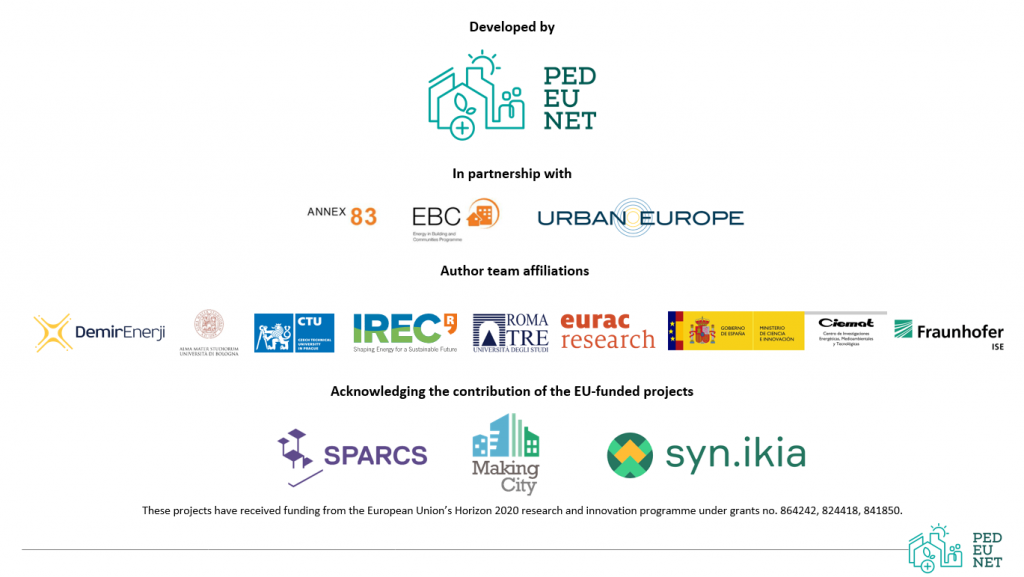| D1P001: Name of the project | |
| D1P001: Name of the project | BIPED - Building Intelligent Positive Energy Districts |
| D1P002: Project assigned code | |
| D1P002: Project assigned code | 101139060 |
| D1P003: Start date | |
| D1P003: Start date | 01/24 |
| D1P004: End date | |
| D1P004: End date | 12/26 |
| D1P005: Ongoing project | |
| D1P005: Ongoing project | Yes |
| D1P006: Funding programme/financing model | |
| FP7/H2020/HEU/DUT | yes |
| FP7/H2020/HEU | Horizon Europe |
| Interreg | no |
| National funding | no |
| Public-Private Partnership - please specify | no |
| Other | no |
| D1P007: Estimated project costs (Mill. €) | |
| D1P007: Estimated project costs (Mill. €) | |
| D1P008: Description of project objectives/concepts | |
| D1P008: Description of project objectives/concepts | The BIPED project is building an intelligent PED model to assist cities with decarbonisation efforts aimed at reaching net zero by 2030. At the core of BIPED solution lies the advanced digital twin technology complete with AI-driven optimisation tools for better urban planning. After the initial deployment in Aarhus, Denmark, BIPED tools and results will be offered to interested adopters across Europe, with a special focus on actors in the climate neutral cities network. |
| D1P009: Description of project upscaling strategies/potential | |
| D1P009: Description of project upscaling strategies/potential | Open technical specifications and guidance will allow cities to replicate and scale the BIPED solution to drive the decarbonisation agenda, especially when it comes to designing and implementing green investment plans necessary to achieve climate-neutrality by 2030. The use of standards, and in particular MIMs (Minimal Interoperability Mechanisms) will be a key enabler of cross-border integration, as well as between domains and systems. New MIMs ensure that the necessary technical requirements are met to provide efficient, scalable data-driven services. The use of European standards for data spaces will enable low-level models to inform higher-level aggregated city models employed in urban planning. |
| D1P010: Number of PED case studies in the project | |
| D1P010: Number of PED case studies in the project | |
| D1P011: Case Study | |
| D1P011: Case Study | |
| D1P012: Description of project expected impact | |
| D1P012: Description of project expected impact |
|
| D1P013: Standardization efforts | |
| D1P013: Standardization efforts | BIPED will build a world-class LDT for the district of Brabrand in Aarhus. Based on the ambitious EU roadmap for Federated LDTs (Digital Europe Programme), MIMS developed in the context of Living-in.EU (MIMs Plus) and the global y.MIM format, the first iteration of BIPED's solution will be created, comprising a detailed semantic 3D model of the physical environment, along with additional geospatial data and soft datasets. The geometrical and visual representation of the digital twin will feature a terrain model, orthophotos, 3D vegetation models, street furniture models, and building models as specified by the OGC CityGML standard with at least Level of Detail (LOD) 2 geometrical and semantical differentiation. Higher LODs with additional information of facade and roof structures will be created as needed. Open standards such as CityGML, GeoJSON, GML, GlTF, and open interfaces such as OGC WMS, WFS, WCS, OGC API Features will be incorporated to a) enable live data exchange with existing spatial data infrastructures and b) ensure portability with IT infrastructures of other European cities. Subsequent iterations will link spatial data with domain specific data and tie in live information from sensors. Depending on local needs and modelling requirements, further integration with traffic networks, IoT sensors, mobility and energy systems may be undertaken to provide an optimal solution for decision making. |
| D1P014: Sources | |
| D1P014: Sources | |
| D1P015: Can you specify a suitable contact person regarding the load-management approach within your PED project? | |
| Name | Henrik Madsen |
| hmad@dtu.dk | |
| D1P016: Would you be willing to share data from your PED project for research purposes? | |
| D1P016: Would you be willing to share data from your PED project for research purposes? | Yes |

Authors (framework concept)
Beril Alpagut (Demir Energy); Giulia Turci (University of Bologna); Michal Kuzmic (Czech Technical University in Prague); Paolo Civiero (Università Roma Tre); Serena Pagliulia (University of Bologna); Oscar Seco (CIEMAT); Silvia Soutullo (CIEMAT); Daniele Vettorato (EURAC Research, IEA Annex 83); Bailador Ferreras M. Almudena (CIEMAT); Vicky Albert-Seifried (FHG ISE)
Contributors (to the content)
Laura Aelenei (LNEG), Nienke Maas (TNO), Savis Gohari (OsloMet), Andras Reith (ABUD), Ghazal Etminan (AIT), Maria-Beatrice Andreucci (Universita Sapienza), Francesco Reda (VTT, IEA Annex 83), Mari Hukkalainen (VTT), Judith-Borsboom (Locality), Gilda Massa (ENEA), Jelena Ziemele (University of Latvia), Nikola Pokorny (CVUT), Sergio Diaz de Garayo Balsategui (CENER, IEA Annex 83), Matthias Haase (ZHAW, IEA Annex 83), Christoph Gollner (FFG, JPI UE), Silvia Bossi (ENEA, JPI UE), Christian Winzer (Zurich University of Applied Science), George Martinopoulos (Centre for Research and Technology Hellas), Maria Nuria Sánchez (CIEMAT), Angelina Tomova (Energy Agency of Plovdiv), Oya Tabanoglu (Demir Enerji), Jelena Brajković (University of Belgrade), Juveria Shah (Dalarna University), Michela Pirro (ENEA), Francesca Sabatini (University of Bologna)
Implemented by
Boutik.pt: Filipe Martins, Jamal Khan
Marek Suchánek (Czech Technical University in Prague)